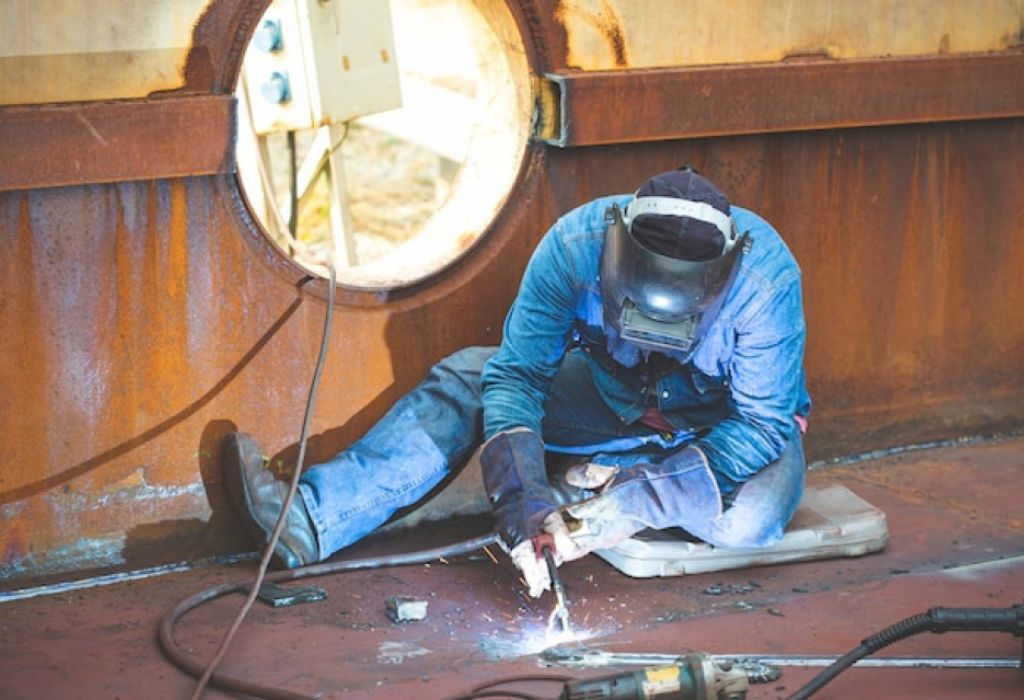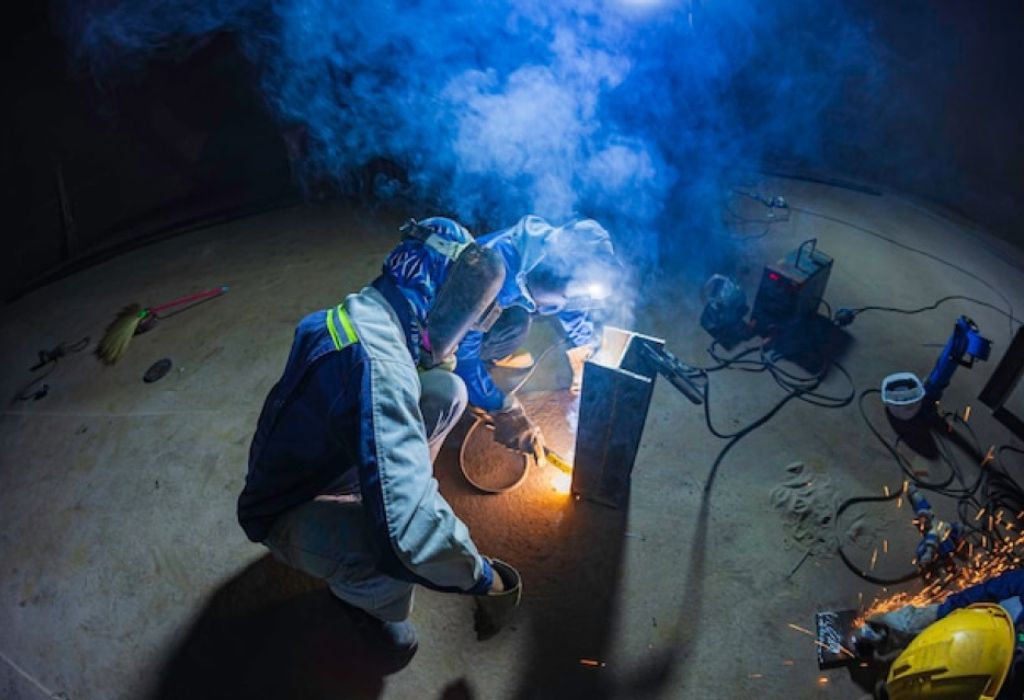Picture working hundreds of feet below the ocean’s surface, where visibility is limited, the pressure is intense, and every weld must be precise to prevent catastrophic failures.
This is the daily reality of diver welders, who combine two highly demanding skills—commercial diving and professional welding—into one of the most specialized careers in the world.
The appeal of this career goes beyond the adrenaline rush.
Many aspiring professionals are drawn by the promise of high earnings, with stories of six-figure salaries and bonuses for deep-water projects.
These figures spark curiosity: is this career really as lucrative as it seems, or is the reality more complicated?
Statistics highlight both the risk and reward of this field. According to the American Welding Society, underwater welding ranks among the most dangerous welding professions, with a higher-than-average accident rate compared to surface welders .
This danger is also why pay rates are considerably higher than many other welding jobs.
In 2025, diver welding continues to be a niche yet vital profession supporting industries like offshore oil and gas, ship repair, underwater construction, and infrastructure maintenance.
Understanding how much a diver welder makes requires examining factors such as experience, job type, certifications, and working environment.
How Much Does a Diver Welder Make in 2025?

Diver welders in 2025 can expect annual salaries ranging from $55,000 to $200,000, depending on the scope of their work. Inland welding jobs usually fall on the lower end of the scale, while offshore saturation divers often reach six figures.
The pay structure varies across regions. Inland projects like repairing dams, bridges, or shipyards pay around $25–$40 per hour, leading to an annual income between $50,000 and $80,000. Offshore divers, especially those in oil and gas industries, often earn double that due to the hazardous conditions.
Day-rate systems are common for offshore divers. Saturation divers, for instance, can earn $1,000–$1,500 per day plus “depth pay,” which increases with every additional foot underwater. With projects lasting several weeks, divers can make $40,000 or more in a single contract.
However, diver welding is not always steady employment. Many projects are seasonal or dependent on oil and gas market demand, meaning income can fluctuate dramatically. This explains why averages are often misleading compared to peak earnings.
Do diver welders make six figures?
Yes, offshore saturation divers frequently earn six figures annually.
What is the average diver welder salary in 2025?
On average, diver welders make $60,000–$100,000 per year, depending on job type.
Do entry-level welders earn less?
Yes, beginners typically earn around $40,000–$60,000 until they gain offshore certifications.
How much can a diver make per day?
Saturation divers can earn $1,000–$1,500 daily, with bonuses for depth.
Is the income consistent year-round?
Not always. Jobs are project-based, leading to high-earning months and slower periods.
Factors That Affect Diver Welder Salaries
Several variables determine how much a diver welder earns, and these differences explain why incomes range so widely across the industry.
The first factor is experience. Divers with more years in the field, especially those who have built a strong reputation, often secure contracts with better pay. Employers trust them to handle dangerous tasks efficiently, which justifies higher wages.
Certifications are another major factor. Basic diving certifications may open entry-level roles, but advanced qualifications like saturation diving and hyperbaric welding drastically increase earnings. Each additional certification signals higher competence and reduced risk for employers.
The type of project also impacts pay. Inland projects like bridge maintenance are essential but less dangerous, so they pay less. Offshore oil rigs and pipeline construction involve extreme conditions, justifying salaries at the top of the scale.
Lastly, geography influences wages. Countries like the U.S., Norway, and the Middle East offer the highest salaries, while developing regions may pay less despite similar risks. Global demand for energy plays a key role in these disparities.
Do certifications raise diver welder pay?
Yes, advanced diving and welding certifications directly boost earning potential.
Which pays more, inland or offshore?
Offshore jobs pay more due to risk and complexity.
Does geography affect pay?
Yes, regions like the U.S. and Norway typically offer higher salaries.
Do union jobs pay better?
Unionized contracts often include higher wages and benefits.
Are specialized skills rewarded?
Yes, hyperbaric and saturation welding skills command premium pay.
Inland vs. Offshore Diver Welders
Inland and offshore diver welding differ significantly in both working conditions and pay scales.
Inland diver welders handle tasks such as repairing dams, bridges, pipelines, and shipyards. Their work is essential for infrastructure maintenance, but the risks are lower compared to deep-sea projects. Inland welders typically earn between $55,000 and $80,000 annually.
Offshore diver welders, by contrast, work in challenging environments on oil rigs, underwater pipelines, and ship hulls. Offshore welding exposes them to greater pressure, low visibility, and potential marine hazards. These challenges translate into higher compensation, often ranging from $100,000 to $200,000 per year.
Offshore work also involves long stints at sea. Divers may spend weeks in saturation chambers, only returning home once the contract ends. While exhausting, the financial rewards are substantial.
Inland work tends to be more stable, with long-term contracts and consistent schedules. Offshore, however, offers shorter bursts of intense work with higher payouts. Choosing between inland and offshore careers depends on personal tolerance for risk and lifestyle preference.
Do inland welders make less?
Yes, inland divers typically earn around $55,000–$80,000 annually.
Are offshore jobs more dangerous?
Yes, offshore conditions are riskier, which is why they pay more.
Which career is more stable?
Inland diver welding offers more consistent work, though lower pay.
Do offshore divers work longer shifts?
Yes, contracts may require 12-hour shifts for several weeks straight.
Which option is better for beginners?
Most start inland before moving offshore as their experience grows.
Risks and Challenges in Diver Welding
Diver welding is rewarding but extremely dangerous. The high salaries reflect the significant risks associated with the job.
The primary danger is drowning, caused by equipment failure, disorientation, or extreme underwater conditions. Poor visibility and strong currents increase the likelihood of accidents.
Another challenge is decompression sickness, or “the bends,” which occurs if divers ascend too quickly. This condition can cause severe pain, paralysis, or even death if untreated.
Divers also face electrocution risks since welding involves electricity underwater. Strict safety protocols and specialized equipment are required to reduce these hazards.
Finally, mental and physical stress take a toll. Divers must endure cramped spaces, long hours, and isolation during offshore assignments. These conditions make diver welding one of the toughest careers available.
Is underwater welding dangerous?
Yes, it is considered one of the most dangerous welding jobs worldwide.
What is decompression sickness?
It’s a condition caused by ascending too fast, leading to nitrogen bubbles in the bloodstream.
Can underwater welders get electrocuted?
Yes, but specialized safety equipment helps minimize the risk.
Do divers face mental health challenges?
Yes, isolation and stressful conditions can affect mental well-being.
Why is pay so high despite the risks?
High pay compensates for danger, skill requirements, and physical strain.
Training and Certification Requirements

To become a diver welder, individuals must complete both diving and welding training programs.
The first step is earning basic commercial diving certification, which covers underwater safety, equipment use, and emergency response. These programs often last several months and cost thousands of dollars.
Next, welders must complete professional welding certifications from organizations like the American Welding Society (AWS). These demonstrate competence in various welding techniques, including SMAW, GMAW, and FCAW.
Advanced certifications are necessary for higher-paying roles. Saturation diving certification, for example, allows welders to work at depths of 200 feet or more. Hyperbaric welding qualifications further open opportunities for specialized offshore work.
Finally, hands-on experience is essential. Most employers prefer divers who have logged hundreds of underwater hours before assigning them to major offshore projects.
What certifications are needed?
Basic commercial diving and professional welding certifications are required.
How long does training take?
It takes several months to a year, depending on the program.
Are advanced certifications necessary?
Yes, for high-paying offshore and saturation jobs.
Do certifications expire?
Yes, most require periodic renewal to stay valid.
Is training expensive?
Yes, programs can cost $15,000–$30,000 or more.
Future Outlook for Diver Welders
The demand for diver welders in 2025 remains strong, driven by industries such as oil and gas, shipping, and infrastructure development.
While renewable energy is on the rise, offshore oil and gas projects are still expanding, particularly in the Middle East, Asia, and the Americas. This ensures continued demand for skilled offshore welders.
Additionally, aging infrastructure in developed nations requires repair, creating opportunities for inland diver welders. Bridges, dams, and harbors all need ongoing maintenance.
However, technology may alter the industry. Robotics and remote-operated vehicles (ROVs) are increasingly capable of performing underwater tasks. Still, human welders remain essential for precision jobs requiring adaptability and problem-solving.
Is demand for diver welders growing?
Yes, especially in offshore energy and infrastructure repair.
Will robots replace diver welders?
Not entirely. ROVs assist but cannot match human adaptability.
Which industries need diver welders most?
Oil and gas, shipping, and infrastructure sectors.
Are jobs global or local?
Both. Offshore divers often travel, while inland divers may work locally.
Is this career future-proof?
Yes, though technology may shift the nature of the work.
Conclusion
Diver welding is a career defined by risk, skill, and reward. In 2025, salaries range from $55,000 to $200,000 annually, with offshore saturation divers at the highest end of the scale. Income depends on experience, certifications, job type, and location, making it a career where ambition and training directly affect pay.
While the dangers are significant, so are the rewards. For those willing to embrace the challenges, diver welding offers not just financial success but also the thrill of working in one of the most extreme environments on Earth.
Final Advice: If you are considering this career, invest in training, pursue advanced certifications, and build experience step by step. The journey is demanding, but the rewards—both financial and personal—can be extraordinary.

I’m Darrell Julian, the founder, lead writer, and hands-on welding enthusiast behind ArcWeldingPro.com. With more than 15 years of real-world welding experience, I created this platform to share what I’ve learned in the field, in the shop, and in the heat of the arc.


